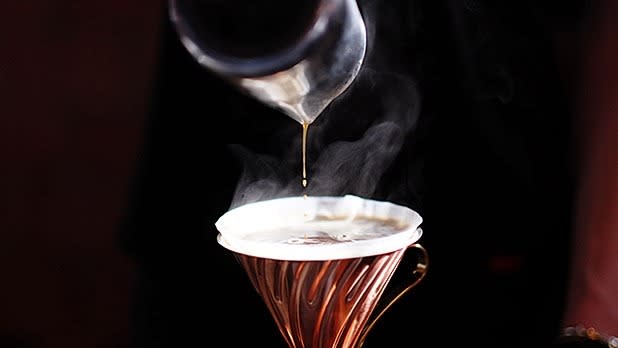How to Make the Perfect Pour-Over Coffee

(Photo Courtesy of John Letoto Courtesy Greenway Coffee Co.)
More people are trading in their French presses and automatic makers to make pour-over coffee at home for a simple reason: it just tastes better. You get the fullest cup of coffee possible. While there is no perfect coffee bean to use for pour overs, there are characteristics to look for in a bean that will help you brew the perfect cup.
“Choosing coffee beans is a matter of personal preference,” says Evan Berger, coffee director at JANE. It’s important to pay attention to the freshness and grind of the bean when making a pour over because this method of brewing brings out coffee’s complex flavors.
Related: The 11 Best Coffee Shops in the U.S.
There is no perfect type of coffee bean for pour overs because everyone has different taste preferences, says Rachael Hayes, lead barista at Twin City Hive, which specializes in pour over coffee. “It would be like saying this type of wine is best for everyone.” Focusing on the harvest date, roast date and grind of the bean will help you make a pour over that highlights the subtle nuances of the particular coffee your choose to brew.
Coffee beans are technically a fruit, says John Letoto, head roaster at Greenway Coffee Company, so you want to make sure the beans you buy are picked when they are ripe, not green. While it can be tricky to get a harvest date–it’s not always printed on the bag–you could ask your barista where the beans were sourced from and when. Some specialty stores like Whole Foods offer information cards about the source of their coffee beans.
Related: 9 Myths About Coffee, Debunked
You want to look for a certain amount of transparency in the sourcing information, Berger says. It’s not enough for the information to say it’s Ethiopian coffee. You want to know what varietal it is, too, Berger says, noting that two of the most respected varietals are Bourbon and Typica.
Roast date
Most coffee roasters have started printing their roast dates on their packaging. Letoto, who has been roasting coffee for nine years, recommends avoiding anything that has a roast date that is more than two weeks old, especially if you are using it to make a pour over. Think of coffee as any other fruit you buy, he says. As the coffee ages, the taste won’t be as crisp or sweet.
Once you buy your beans, if keep them at room temperature in an airtight, glass container with a sealed top, they should be good for two or three weeks. Also, don’t refrigerate your beans.
Related: How to Brew a Better Cup of Coffee
Grind
Having a consistently ground bean is the most important factor in making a pour over. At home, most people use a coffee grinder with a blade but baristas agree the trick to getting a uniformed grind is to use a burr grinder, which uses a mill, instead of a blade, and allows you to choose the size of the grind.
You want a grind that has the coarseness of sea salt, Hayes says, because it allows the grounds to be immersed with water, better extracting the flavors from the beans. An even grind size will allow you to maximize the coffee bean’s sweetness and balance it against the bitterness. Be sure to grind you coffee seconds before you plan to brew it because coffee starts to go stale five minutes after being ground, Hayes says.
Related: 6 Habits That Are Aging
Baristas also recommend weighing your coffee before brewing. The standard amount of ground coffee needed to make a pour over is 25 to 30 grams, Hayes says. If you want a stronger cup, use more grams.
Brewing the perfect pour over is a bit like a science experiment. You might need to slightly change your brewing perimeters – the type of grind, the amount of coffee and the temperature of the water, which should be 200 degrees – to create a well-balanced cup of coffee where acidity, sweetness and bitterness all work together.
By Lisa Rabasca Roepe
More from Men’s Journal:
10 Best Brunch Spots in America
